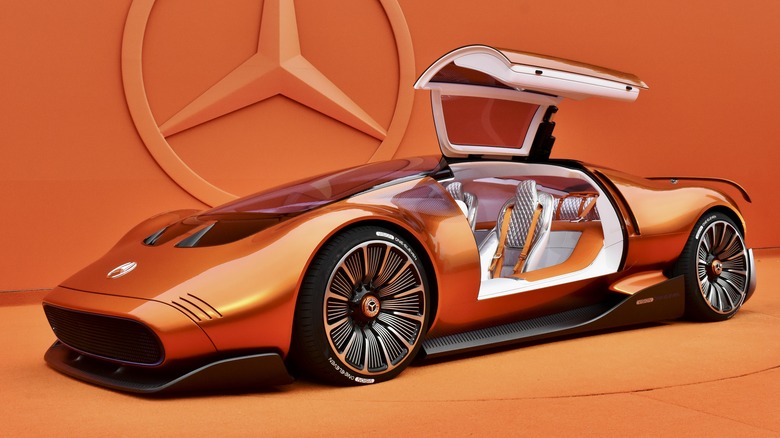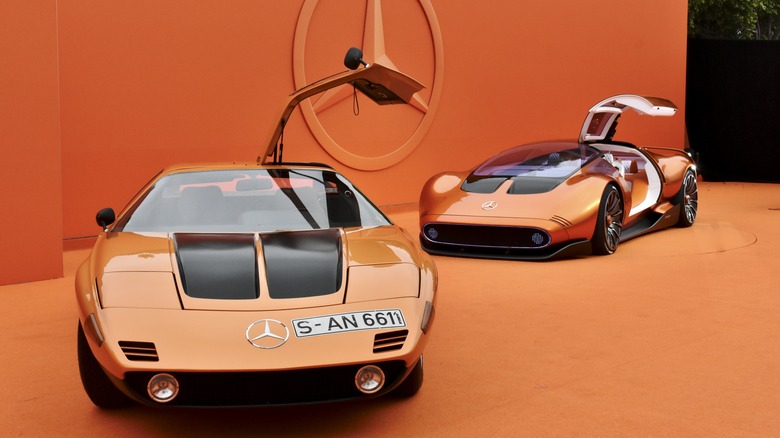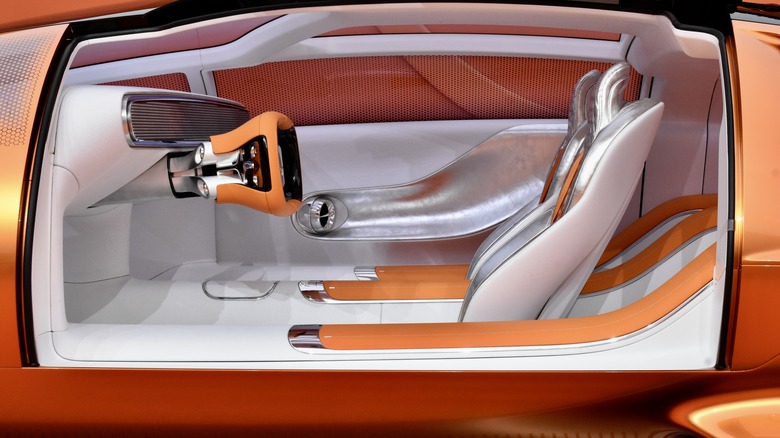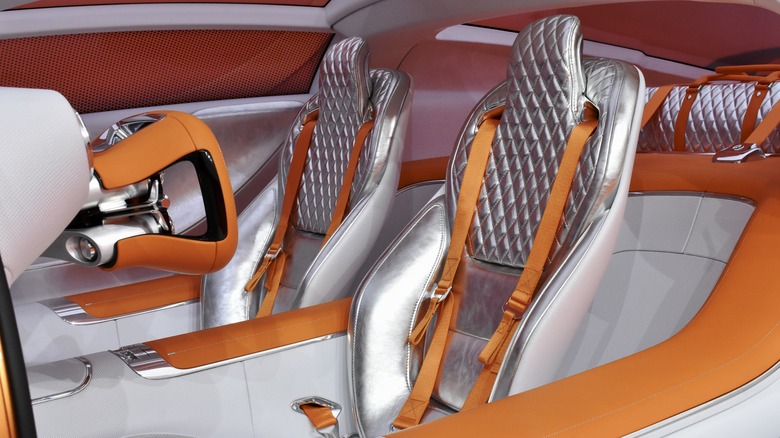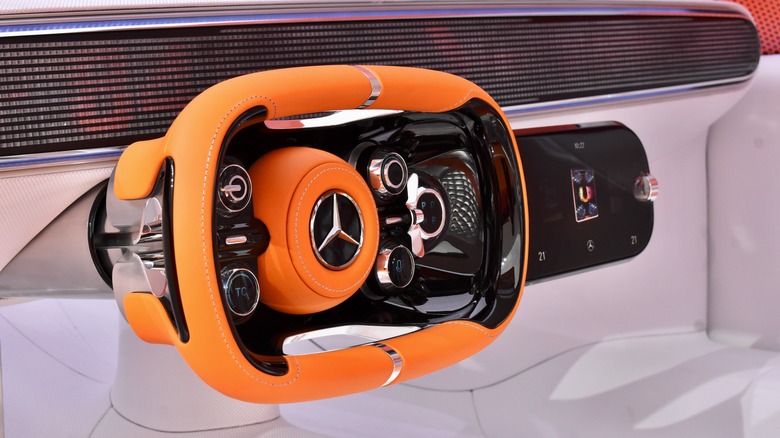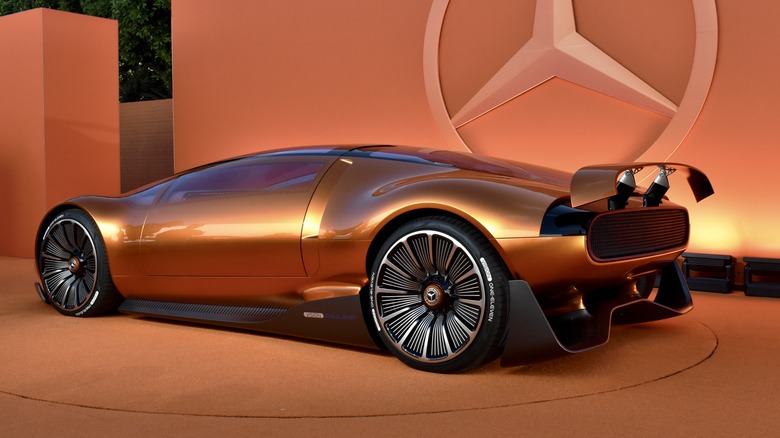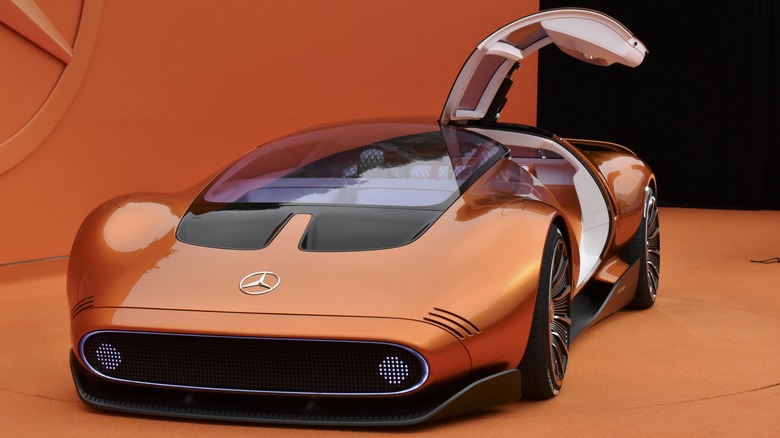Mercedes' New EV Concept Honors A Pioneering Prototype In More Than Just Style
Concept cars traditionally use radical styling to draw attention to automakers' future plans, or to an important piece of an automaker's history. The Mercedes-Benz Vision One-Eleven does both.
The Vision One-Eleven is inspired by the Mercedes-Benz C111 series of prototypes, which Mercedes used to test new technologies and ideas throughout the 1970s. In the spirit of the C111, the Vision One-Eleven sports some new technology of its own, including a different type of electric motor and elaborate augmented reality integration.
With its gullwing doors, beautifully detailed exterior surfaces, and a color palette that combines orange paint and silver leather upholstery, the Vision One-Eleven definitely draws attention. It isn't just a bauble, though. It's a car with a story to tell.
Retro futuristic
Even the most staid automakers will occasionally do something crazy, and in the late 1960s the engineers and designers at Mercedes got their chance. Unveiled in 1969, the C111 prototypes were a bold styling statement that also tested new technology.
Between 1969 and 1979, Mercedes built and tested 16 cars — 11 of which survive — with the same wedge-shaped bodywork (with modifications for later cars) and gullwing doors—about a decade before the DeLorean DMC-12 used that combination to achieve iconic status.
The C111 isn't as well remembered today as the DeLorean, or the many other designs that shared its general shape, but it was a big deal back in the day. That's because the fleet of carrot-like coupes were both show cars and research vehicles.
When they weren't wowing auto-show crowds, they were at test tracks running different powertrains, ranging from a 2.4-liter rotary engine to a turbodiesel. The cars set multiple records, with one member of the fleet reaching 200 mph at Italy's Nardo test track in 1978. In a way, these cars were predecessors to the modern Mercedes Vision EQXX, the one-off EV Mercedes built to push the limits of efficiency. Like the EQXX, the C111 wasn't meant for production, but it wrapped new tech in a package that looked like a real car.
Bigger and bolder
With its gullwing doors, orange-and-black color scheme, and deep front air outlets, the Vision One-Eleven is clearly a descendent of the C111. But it's also an acknowledgement that automotive design trends change.
The C111's flat body sides have been replaced with a cigar-like cross section and its long hood (unnecessary, as the engine is in the back) was deleted in favor of the same short overhang that's an obligatory mention in every automaker press kit. And like too many modern cars, the Vision One-Eleven makes its predecessor look undersized by comparison. Standing just 46 inches tall, it's certainly sleek and low-slung. But the bodywork oozes around the massive wheels and down toward the pavement, making for a less elegant look than the crisp C111.
"This was really the challenge, getting the feel of the original car into a new one with different proportions," Matthias Schenker, part of the team responsible for shaping the Vision One-Eleven, said in a conference room at Mercedes' California design center, located in an anonymous office park in the coastal city of Carlsbad.
Modernizing a classic
To make a modern version of a car designed in 1969, designers looked at other distinctive features of the C111, such as the ovoid headlight and taillight housings, and the black lower bodywork, Schenker explained.
Instead of conventional lights, the Vision One-Eleven has dot-matrix displays that project small circles of light at the corners, as in the original car, but can also be reconfigured to display text, all in an appropriately retro pixelated manner. This is also the only external lighting, as the C111's pop-up headlights were deleted. This is a concept car, remember.
Designers also transformed the black lower body elements into aero devices. A front spoiler and rear diffuser dangle off the bodywork on struts, while side skirts extend outward from the round lower body, ending in winglets that wouldn't look out of place on a Boeing 737. Unlike actual airplane hardware, however, it's unclear if these bits provide any real aerodynamic benefit. But they certainly look cool.
"As a designer, it's one of the dream cars you could work on," Schenker said. Mercedes has many iconic cars worthy of a modern tribute, but the C111 seemed like the most appropriate because of its role as a powertrain testbed, he explained. That ties into some of the new technology Mercedes is showing off here.
Axial flux capacity
The Vision One-Eleven is also one of the first applications of axial flux motors from YASA, a British firm Mercedes purchased in 2021. Prior to that YASA developed motors for the Ferrari SF90 Stradale plug-in hybrid, as well as a 1,500-horsepower electric race car that won the Pikes Peak International Hill Climb.
Electric motors rely on a magnetic field to spin and thus turn electricity into mechanical force. Most EV motors are radial-flux designs, so named because magnetic forces radiate out from the spinning rotor to the stationary stator. Axial-flux motors, which are the same type as used in CD drives, distribute magnetic forces along their axes, and sandwich the stator between two rotors.
This arrangement of parts produces a slimmer motor, and requires less iron, which reduces weight. Mercedes and YASA claim the motors used in the Vision One-Eleven — one powering each rear wheel — are one-third smaller and one-third lighter than conventional motors. That's why Mercedes is eying YASA's hardware for future electric sports-car motors. For now, though, the automaker isn't talking specifics. Mercedes and YASA won't say how much power the motors used in the Vision One-Eleven make, and no specs for the battery pack were provided either. Mercedes did say the pack was developed with expertise from its Formula One powertrain division, though.
Augmented reality on board
Like the original C111 prototypes, the Vision One-Eleven's cockpit is a simple affair, albeit one sporting silver leather, orange seatbelts, and fitted luggage. Surprisingly, considering the dashboard-spanning Hyperscreen displays in current Mercedes-EQ production cars, there aren't even many screens. That's because most of the informational distribution is done via augmented reality.
Sitting in the cockpit, a person wearing a Magic Leap 2 headset can see points of interest highlighted as they drive along, a big red line to direct them where to go, and can even see images of what's on the other side of a door or roof pillar for the ultimate blind-spot monitoring system. That's particularly helpful in overcoming the Vision One-Eleven's low seating position, which makes seeing over the dashboard difficult for anyone short enough to comfortably fit in the car.
Mercedes demonstrated all of these features in a mockup of the Vision One-Eleven cockpit, filling the blank space of ordinary reality with arrows, icons, and other digital paraphernalia that would normally be confined to a screen, but was allowed to float freely across the dashboard. It's impressive technology, so impressive that it almost makes you forget how ridiculous you look sitting in an empty room pretending to drive. Almost.
Mercedes doesn't actually expect people to wear headsets while driving, and has no firm plans to offer anything more sophisticated than the augmented reality navigation systems already available in production models like the S-Class. UX designers explained that this is just one possible way to convey information with less distraction, noting that it could also make use of the many sensors already built into modern cars. The thinking goes that, instead of relying on screens that need their own peculiar graphics, information can be shown in the driver's field of vision in a more intuitive way.
A murkier vision of the future
The Vision One-Eleven is in some ways more relevant than the average concept car, but also less ambitious than the original C111 program.
Most concept cars are just pretty faces, meant to let designers express their creativity in unfettered form, and maybe preview the new grille design that's coming with the next round of midcycle refreshes. The Vision One-Eleven at least serves as a platform for new technology—in the form of its axial-flux motors—that Mercedes actually intends to use in future production cars.
However, this is still just a design exercise. Mercedes has no plans to use the Vision One-Eleven to test axial-flux motors, as the C111 did with the cutting edge internal-combustion powertrain tech of its day. In fact, like most concept cars, the Vision One-Eleven can't even be driven more than a few feet at a time. It can roll onto an auto-show stage, but that's about it.
So while the Vision One-Eleven is a stunning concept—it's a shame, really, that so few people will get to see it in person—that should give car enthusiasts a reason to be optimistic about the future, it doesn't quite live up to the legend.
